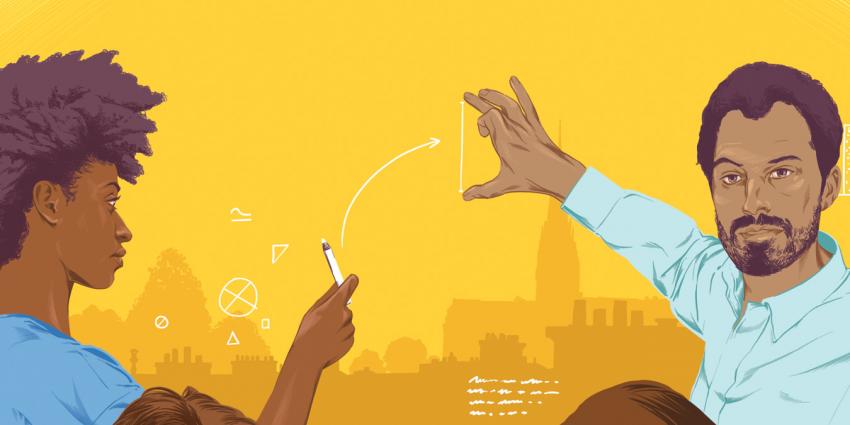Interview with Julie Battilana, Professor at Harvard Kennedy School and Harvard Business School, and Faculty Chair of the Social Innovation and Change Initiative at Harvard Kennedy School. Translated from French by Gillian Eaton.
In your view, how does social innovation, whether it takes the form of an object or process, contribute to the transition towards a sustainable development model? And under which conditions?
Julie Battilana. Social innovation refers to innovations that seek to find a solution to a well-defined social problem, in areas as varied as education, health, economic development, the exercise of citizenship, and environmental protection, among others. You are right to emphasize that this innovation not only takes the form of new products, but also new processes and new social practices. Social innovation can also be developed not only by social enterprises, public institutions, associations, and activists, but also, in some circumstances, by private companies. What counts is the capacity of social innovation projects to have a lasting positive social impact, whoever is behind them, i.e., to improve the lives of individuals and their communities and be environmentally friendly.
But beware! Not every social problem requires something fundamentally new to be created or a completely new processes to be implemented. Some social problems can be addressed by adapting existing solutions from other contexts, or by pursuing an incremental improvement process in existing organizations and ecosystems. Although this may seem less spectacular, it can make for reassuring, less costly, and more easily acceptable solutions than radical innovation.
However, in some cases, innovation is required to address a social problem. Let's take the example of three social innovators with whom we worked at the Social Innovation and Change Initiative (SICI) within the framework of our incubator for social innovation projects developed by some of our students at Harvard. Micaela Connery wanted to tackle the issue of the lack of affordable housing that is inclusive of disabled people in the US, where infrastructure is still lacking. On the other side of the world, in Bangalore, another of our alumni, Manivannan Ponniah, a senior civil servant in the Indian Administrative Service, has launched an association to empower citizens to get involved in local government. Their first challenge was the thousands of tons of waste generated on a daily basis in the Bangalore area, and citizen complaints about uncollected waste. The association has developed a mobile app to reliably collect citizens' complaints and facilitate the work of waste collection companies. In addition, Dr. Dennis Addo, a Ghanaian medic, has launched Wala Digital Health, a platform that connects blood donors and recipients to tackle the serious shortcomings of the blood transfusion system in Ghana, where to date blood donation is not a social norm.
In all three cases, Micaela, Manivannan, and Dennis have had to innovate locally to find solutions for the problems that they hoped to help solve. These sorts of projects play a pivotal role in the development of a new sustainable development model in the regions where the social innovators work. Social innovators are undeniably helping to bring about the transition to this sort of sustainable development model all over the world. However, bringing about the transition is not straightforward, quite the contrary in fact.
Indeed, for social innovation, project developers are often faced with a challenge I study in my research: they have to implement social change which breaks with existing power hierarchies and norms, and this sort of change is particularly difficult to impose because it generates more resistance. Social innovators tend to be brimming with passion and full of good intentions, but the problem is that they often fall into a trap: they ignore the power dynamics embedded in their innovations. They focus on the technical aspect and brush aside the interpersonal or political aspects, which are essential if their innovation is not to remain at the trial stage, but instead is to be scaled up and have a large impact. Take the example of waste sorting. The adoption of wasting sorting is not simply a question of organizing waste collection or waste processing techniques; there is also a need to change the habits of manufacturers and consumers so that they produce less waste, and more easily recyclable waste. What is at stake too is making sorting waste a part of everyday life, convincing local councils to collect different types of waste separately, etc. All of this involves being able to influence a lot of people, and therefore being aware of and understanding how to leverage power. In my view, understanding how to leverage power is a key success factor for social innovation.
This is why at SICI I have developed a support structure that helps social innovators to identify the interpersonal, organizational, and societal power dynamics at work in the solutions that they put forward. My work has enabled me to identify the 3Ps used to analyze these dynamics: the idea is to understand the problem being addressed by the social innovators, as well as the person(s) who are going to try to effect the change, and the innovation pathway, in order to implement the social innovation in question. These three dimensions are iteratively studied in order to analyze where they together align and where they do not. Based on this information, a model for action can be developed in order to contribute to positive social impact.
This evaluation matrix has the advantage of discouraging one-size-fits-all solutions and instead encourages social innovators to find the "bespoke" combination that fits the problem that they are helping to solve, and the political, institutional and social contexts in which they are working. By finding the area where the 3Ps (problem, person, and pathway) intersect, social innovators, including those who are not in positions of power at the outset, can be able to make headway.
At SICI, we enable social innovators to learn how to take into consideration the power hierarchies present in their settings, and therefore in their solutions, and to understand their own sources of power. They identify their allies and beneficiaries, their opponents, and those who are undecided, and they learn to more effectively mobilize their networks. This is vital, as in most cases, a social innovator cannot achieve an impact without others: the innovator has to mobilize collective action so that their innovation brings about social change, and as a result has a positive impact on the community as a whole. By making social innovators aware of the impact of power relations and hierarchies, we help them to avoid some unintended consequences of their innovations and to achieve an impact at an appropriate scale.
To sum up, social innovation plays a pivotal role in the transition towards a sustainable development model, but it is not enough in itself. Social innovation needs to be overwhelmingly adopted for it to constitute a new model. To do so, organizational habits, norms, and people's beliefs need to be changed, which requires a good understanding of power relations.
As is the case in France and Europe, are you supportive of special recognition and support for social innovation, distinct from other forms of innovation?
Of course! Social innovation needs its own tools and support mechanisms. Social innovators who opt to go off the beaten track in order to advance social change come up against the difficulties typically encountered by entrepreneurs (access to human and financial resources, etc.), and also those stemming from the fact that they land in an economic, social, and cultural environment which is often designed to reinforce the status quo, not to embrace new ways of doing things. Dedicated support is therefore needed to help them to overcome the challenges that they face. The same goes for social innovators in other sectors.
Take the example of social entrepreneurs who set up hybrid organizations, which pursue not only financial but also social and environmental aims. This is one of the forms of social innovation that I have studied over the past few years. Work integration social enterprises and micro-credit enterprises are examples of hybrid organizations. The people setting up these kinds of organizations and who are endeavoring to contribute to the development of a new business model face unique challenges and need better support as they undertake their work.
With regard to recognition and support for hybrid organizations, we are seeing that new legal forms, designed to better cater to the specific features of these social enterprises, have started to emerge in Europe, including in France, and worldwide. However, the interviews that I have conducted with founders of social enterprises over the past few years suggest that consultancy firms and legal advisors still often tend to discourage founders from utilizing these new statuses because of a lack of knowledge on their part and/or uncertainty related to them. Focused support is therefore needed in this area, or the ecosystem will bring these innovators back to the status quo.
Above and beyond legal identity, the issue of legitimacy tends to be raised for hybrid organizations in their dealings with external partners. To survive and thrive, they need to be legitimate in the eyes of all the stakeholders, from the business to the social sector. However, as they transgress the established models of both the business and social sectors, they run the risk of not meeting the typical expectations of these diverse partners. Work integration social enterprises, for instance, must simultaneously meet the economic efficiency requirements of their funding bodies and clients, and the social priorities of the other stakeholders who support their social remit, such as partner non-profits or public sector partners. Even in France, where the context is favorable because work integration social enterprises benefit from robust public support, research shows that they sometimes still lack legitimacy in the eyes of business and social stakeholders.
This issue of legitimacy is critical because it is a determinant of access to financial resources and the ability to attract a qualified workforce. Furthermore, research shows that because of their hybrid nature, social enterprises often find it harder to leverage funds and recruit trained workers to work in these sorts of organizations. This is why for all of these aspects – a bespoke legal status, legitimacy, access to funding, and trained and qualified workers to work in this sector – social entrepreneurs would need dedicated support. That being said, once again, we need to refrain from seeing innovation as the Holy Grail, and this also applies to social innovation. "Ever more innovation" often sounds like a mantra with an ideological overtone, while a positive social impact is not always increased by innovation. Support for social innovation must not obscure the fact that the transition towards a more sustainable model of development often involves existing organizations that we also need to know how to support and not hinder their efforts.
You have one foot in the US and the other in France. Do you feel that social innovation is defined differently in the two countries?
Based on the institutional, political, and social framework, and governance traditions, it is clear that social innovation does not necessarily go through the same channels. In continental Europe, in France for instance, where the welfare state has historically played an important role, there will be high expectations of the state in terms of implementing social innovation. Meanwhile, in the English-speaking world, and in the US specifically, where state intervention is traditionally more limited, the focus will instead more often be on civil society for social innovation and its rollout.
However, some common constants can be seen in all countries. Every year at SICI we support social innovators from all corners of the globe. The idea, need, and motivation to innovate in order to improve the lives of people and community goes beyond borders and can be seen in these innovators. The way in which they are able to develop their innovation varies based on their particular context. Hence the importance of helping them with an evaluation grid such as the 3Ps, which does not provide one-size-fits-all solutions but encourages them to identify the "bespoke" combination suited to the problems that they are trying to address, and to the political, institutional, and social context in which they are working.
What linkages can there be between social innovation primarily but not exclusively undertaken by civil society stakeholders and public policy? Can innovation fuel and help develop public policy, or is it destined to replace it?
My research in the private, public, and social enterprise sectors has brought to light key ideas for accelerating social change. These ideas support the need for public policy and social innovation to dovetail. They can be complementary, and they are also not mutually exclusive. The range of challenges faced by social innovators is likely to vary based on the context. A recent empirical study of microfinance organizations in over 100 countries has shown, for example, how much the balance that needs to be struck between a financial and social rationale hinges on the cultural context. Moreover, these tensions may well evolve over time. However, in the future, these tensions could be become less intense if the environment changes and better meets the needs of social innovators. Governments can contribute to this by changing the rules of the game in order to facilitate the work of social innovators and provide them with better support. In fact, some of these policies themselves might be considered innovations. Additionally, new investments will be needed to step up the pace of research and the management of social innovation that addresses the pressing issues of our time.
Above and beyond this kind of support, collaboration between social innovators and government is often key in order to scale up social innovation that has proved its worth at the local level. When innovation exists and has been well thought out, tested, and is feasible, scaling up often requires a partnership with the public authorities. Government therefore has multiple roles to play in order to support social innovation.
Mohamed Aburawi, one of our social innovators at SICI, is a doctor from Libya, and his project is a perfect and highly relevant example of this synergy, particularly in the context of the COVID-19 crisis. During his studies at the Kennedy School, we supported Mohamed in developing a telehealth app to link up diaspora doctors with Libyans needing a medical appointment. He is now working with the Libyan government, which has selected his app, Speetar, as the government's main method of intervention with the country's population. The Speetar COVID-19 app was rolled out in record time in order to effectively triage patients based on their symptoms and risk level, and alleviate saturation of the country's health services, which are already severely tested by a lack of resources.
However, it is not just social innovators and the public authorities who need to work together to bring about the transition to a sustainable development model. Lasting social improvements will require all the stakeholders to make a collective effort to change, including businesses, associations and citizens. All too often innovators work away in isolation, separated from the stakeholders who could help to embed their social innovation in everyday practices. On the contrary, they need to work not only with civil society and governments, but also with business, the third sector, academia, start-ups, etc. This collaboration is needed if the transition towards a sustainable development model is to take place.
What bridges need to be constructed between the world of research and social innovators?
As a researcher and citizen who recognizes the magnitude of the social, environmental, and economic issues that we are facing, I am more convinced than ever of the importance of links between research and practice. This is why I created the Social Innovation and Change Initiative (SICI) at Harvard. The initiative seeks to build this bridge between academics and practitioners.
Over the past few decades, new, more democratic and more sustainable working and organizational methods have been developed across the world. In the academic community, some of us have studied and analyzed these initiatives. This is how we can contribute to the efforts to redesign our system by sharing our research findings and by helping to evaluate the new social innovations that will be put in place to address the challenges.
In partnership with two researchers and professors, Isabelle Ferreras and Dominique Méda, I have also helped to launch an initiative which aims to mobilize academia to play an active part in this redesign. We published an op-ed about the urgent need to democratize work and we are proposing models of shared governance. Over 4,000 researchers have signed the manifesto since it was published in 40 media outlets worldwide. The challenge is now for researchers to work with social innovators, who have already piloted these new models, and governments, to put in place public policies which can speed up the transition to fairer, more sustainable, and more democratic organizational models.



